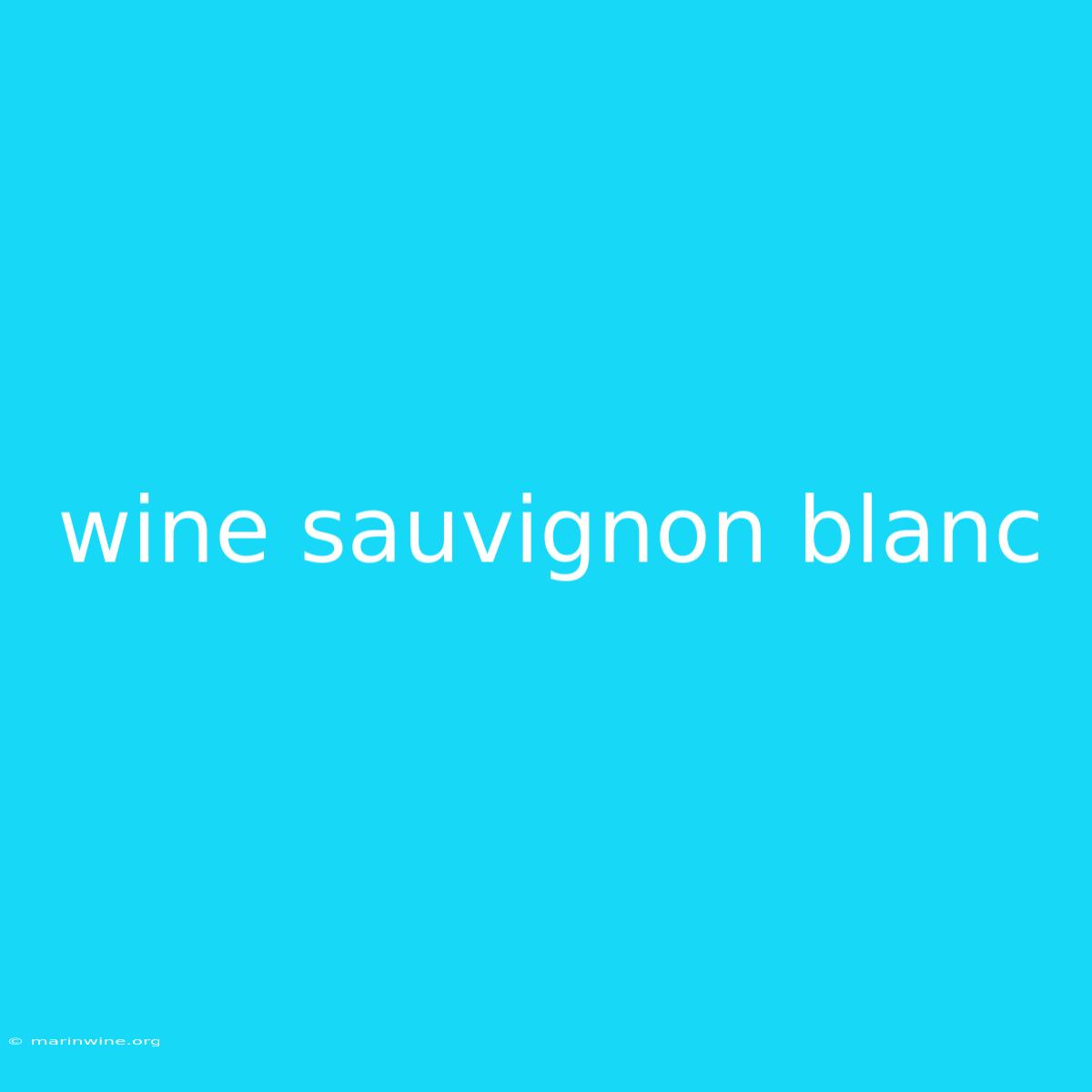Sauvignon Blanc: Unlocking the Secrets of This Refreshing Wine
Have you ever wondered what makes Sauvignon Blanc so popular? This crisp, aromatic white wine has become a global favorite, captivating palates with its vibrant flavors and versatility.
Why It Matters: Sauvignon Blanc is one of the most widely planted white grape varieties worldwide. Its popularity stems from its ability to express terroir, producing wines with distinct regional characteristics. From the grassy notes of New Zealand to the citrusy complexity of Sancerre, there's a Sauvignon Blanc for every preference.
Key Takeaways of Sauvignon Blanc:
| Feature | Description |
|---|---|
| Origin: | Originally from the Bordeaux region of France, Sauvignon Blanc has since spread to numerous wine regions around the globe. |
| Taste Profile: | Known for its crisp acidity, herbaceous aromas (think grassy, leafy, and green pepper), and fruity notes (like citrus, passionfruit, and gooseberry). |
| Food Pairings: | Exhibits a wide range of pairing options, from seafood and salads to goat cheese and Asian cuisine. |
| Style and Complexity: | Sauvignon Blanc can range from simple and fruity to complex and mineral-driven, reflecting the winemaking techniques and terroir. |
Sauvignon Blanc: A Closer Look
Understanding the Grape Variety
Sauvignon Blanc is a relatively early-ripening grape, prone to producing high-acidity wines. Its thin skin and small berries contribute to its vibrant fruit expression.
Key Aspects of Sauvignon Blanc:
- Terroir and Climate: The grape is highly sensitive to its surroundings, with climate and soil playing a significant role in the final wine's characteristics.
- Winemaking Techniques: Winemakers have various techniques at their disposal to influence the final wine's style, including oak aging, fermentation methods, and blending.
- Style and Flavor Profiles: Sauvignon Blanc can showcase a diverse range of flavors, from grassy and herbaceous to tropical and citrusy, depending on the region and winemaking techniques.
Exploring the Relationship Between Terroir and Flavor
The unique connection between Sauvignon Blanc and its environment is a key factor in its global appeal.
New Zealand:
- Introduction: New Zealand's Sauvignon Blanc is renowned for its intense grassy and tropical fruit flavors.
- Facets: The country's cool climate and long, sunny days promote the development of vibrant acidity and distinctive aromas.
- Summary: New Zealand Sauvignon Blanc is a shining example of how terroir can shape a wine's character.
France (Sancerre):
- Introduction: Sancerre, a region in the Loire Valley of France, is known for its elegant and mineral-driven Sauvignon Blanc.
- Facets: The region's chalky soil and cool climate contribute to the wine's crisp acidity and flinty notes.
- Summary: Sancerre Sauvignon Blanc exemplifies the interplay between soil, climate, and winemaking techniques in producing a unique and complex expression of the grape.
Beyond the Basics
Sauvignon Blanc is a versatile wine that offers an exciting journey of discovery. Exploring its various styles and flavors can be both educational and enjoyable.
Sauvignon Blanc: A World of Flavor
| Region | Key Flavor Profile | Additional Information |
|---|---|---|
| New Zealand | Intense grassy, passionfruit, gooseberry | Often unoaked and bottled early for freshness |
| Sancerre (France) | Mineral, citrus, flint | Can be aged in oak for complexity |
| South Africa | Floral, tropical fruit, grapefruit | Often produced with a focus on fruit-forwardness |
| California (US) | Citrus, melon, herbal | Can showcase a wider range of flavors, from restrained to bolder styles |
| Chile | Citrus, grassy, green apple | Known for its affordability and quality |
FAQ for Sauvignon Blanc
-
Q: Is Sauvignon Blanc a sweet wine?
-
A: Generally, Sauvignon Blanc is a dry wine, meaning it has minimal residual sugar.
-
Q: What are some good food pairings for Sauvignon Blanc?
-
A: Seafood (especially shellfish), salads, goat cheese, Asian cuisine, and light vegetarian dishes.
-
Q: How do I store Sauvignon Blanc?
-
A: Store Sauvignon Blanc in a cool, dark place, preferably between 45-55 degrees Fahrenheit, to preserve its freshness and flavor.
-
Q: How long does Sauvignon Blanc last?
-
A: An unopened bottle of Sauvignon Blanc can typically last for several years, while an opened bottle is best consumed within a few days.
-
Q: What is the difference between Sauvignon Blanc and Pinot Grigio?
-
A: Sauvignon Blanc has a more pronounced grassy, herbaceous character, while Pinot Grigio is typically lighter and more citrusy.
-
Q: How do I know if a Sauvignon Blanc is good?
-
A: Look for a bright, clear appearance, a lively acidity, and balanced aromas of fruit, herbs, and minerals.
Tips for Enjoying Sauvignon Blanc
- Chill it: Sauvignon Blanc is best enjoyed chilled, around 45-50 degrees Fahrenheit.
- Explore different styles: Don't limit yourself to one type of Sauvignon Blanc. Experiment with wines from various regions and producers to discover your favorites.
- Pair it with food: Try pairing Sauvignon Blanc with different dishes to explore the wine's versatility.
- Drink it young: Sauvignon Blanc is often best enjoyed when young, but some wines can benefit from a few years of aging.
- Pay attention to the label: Look for information about the wine's region, producer, and vineyard to gain insights into its character.
Summary of Sauvignon Blanc
Sauvignon Blanc is a delightful white wine with a distinct personality. Its versatility, from grassy and herbaceous to tropical and citrusy, makes it a joy to explore.
As you continue your wine journey, remember to embrace the beauty of Sauvignon Blanc. Its refreshing flavors and adaptability to various food pairings make it a perfect companion for any occasion.

